While gymnastics is a beautiful and exciting sport that showcases impressive displays of strength, flexibility, and coordination, it is not without its risks.
Athletes in gymnastics face various challenges, and one of the most significant dangers is overexertion. Overexertion occurs when athletes push themselves beyond their limits, leading to serious physical and mental consequences.
In this article, we will explore the dangerous effects of overexertion in gymnastics and provide insights on how to prevent injury and promote overall well-being.
1. Increased Risk of Injury
Gymnastics demands rigorous training and frequent repetition of complex movements, making athletes vulnerable to injuries. When gymnasts overexert themselves, their muscles, tendons, and joints are subjected to excessive strain and stress.
This heightened strain significantly increases the risk of acute injuries such as sprains, strains, dislocations, and fractures. Additionally, overexertion weakens the body’s ability to recover, leaving athletes susceptible to overuse injuries like tendonitis and stress fractures.
2. Mental Exhaustion
Overexertion not only affects gymnasts physically but also mentally. The relentless pursuit of perfection in gymnastics can lead to mental exhaustion, often referred to as burnout.
Gymnasts who push themselves beyond their limits may experience feelings of frustration, demotivation, and even depression. The pressure to constantly improve and meet high expectations can negatively impact their mental well-being, leading to a decline in performance and a loss of passion for the sport.
3. Decreased Performance
Contrary to the desired outcome, overexertion tends to hinder performance rather than enhance it. When gymnasts push themselves excessively without allowing enough time for rest and recovery, their bodies become fatigued.
Fatigue leads to reduced muscular coordination, decreased power output, and compromised timing, which can significantly impact performance execution. Overexertion also hampers concentration and focus, resulting in mistakes, falls, and lower scores during competitions.
4. Stunted Progression
Gymnastics is a sport that demands steady progress and continuous skill development. However, overexertion can impede an athlete’s ability to progress effectively.
When gymnasts overstrain their bodies, they are more prone to injuries that require time away from training. This forced break can hinder skill acquisition and disrupt the natural progression of an athlete’s training.
Additionally, the mental and physical effects of overexertion can lead to decreased confidence, making it challenging to learn and master new skills.
5. Burnout and Dropout
Unfortunately, the dangerous effects of overexertion in gymnastics can lead to burnout and eventual dropout from the sport.
The intense training schedules, pressure to compete, and constant demand for perfection can take a toll on an athlete’s physical and mental well-being. When gymnasts experience burnout, they may develop a negative association with gymnastics, leading to a loss of interest and motivation.
Over time, this can result in athletes deciding to quit the sport altogether, depriving them of the many benefits that gymnastics offers.
6. Psychological Stress
In addition to physical strain, overexertion can cause significant psychological stress among gymnasts. The constant pressure to perform flawlessly, meet expectations, and strive for perfection can contribute to increased anxiety and stress levels.
This psychological stress can manifest in various ways, such as sleep disturbances, changes in appetite, mood swings, and even panic attacks or anxiety disorders. The combination of physical and psychological stress can have detrimental effects on an athlete’s overall well-being.
7. Impaired Immune Function
Overexertion can weaken the body’s immune system, making athletes more susceptible to illnesses and infections.
Intense training sessions without sufficient rest and recovery periods can result in chronically elevated levels of stress hormones, which suppress immune function. This suppression can lead to frequent illnesses and a prolonged recovery process. When gymnasts are constantly battling illnesses, their training suffers, and their overall health and well-being deteriorate.
8. Poor Nutritional Status
Overexertion in gymnastics often goes hand in hand with poor nutritional practices. In pursuit of a lean and toned physique, athletes may restrict their calorie intake or adopt harmful dietary habits.
Insufficient energy intake affects performance, impairs recovery, and increases the risk of nutrient deficiencies. Additionally, overexertion can disrupt hunger and satiety cues, leading to disordered eating patterns such as binge-eating or restricting food intake.
These poor nutritional practices further exacerbate the negative effects of overexertion on athletes’ health.
9. Long-Term Consequences
The harmful effects of overexertion in gymnastics can extend well beyond an athlete’s competitive years. Without proper care and attention, the physical and mental strain endured during training and competitions can leave lasting impacts.
Chronic injuries, musculoskeletal imbalances, and mental health disorders developed as a result of overexertion may persist into adulthood and have long-term consequences on an athlete’s overall quality of life.
10. Prevention and Well-being
Recognizing the dangers of overexertion, it becomes crucial to prioritize prevention and promote overall well-being in gymnastics. Coaches, trainers, and athletes should implement strategies to prevent overexertion and reduce the risk of injuries.
These strategies include proper warm-up exercises, gradual progression of training intensity and volume, sufficient rest and recovery periods, regular physical therapy and rehabilitation, and open communication channels to address athletes’ physical and mental needs.
Furthermore, it is essential to foster a healthy training environment that emphasizes the importance of balance and discourages excessive pressure.
Coaches should prioritize an athlete’s long-term development, creating training plans that consider individual abilities and recovery needs. Athletes, in turn, should listen to their bodies, communicate their concerns, and actively participate in developing personalized training regimens that prioritize their well-being.
Conclusion
Overexertion in gymnastics poses significant risks to athletes’ physical and mental health.
The increased likelihood of injuries, mental exhaustion, decreased performance, and stunted progression are just a few of the dangerous effects that gymnasts face when pushing themselves beyond their limitations. It is crucial for athletes, coaches, and trainers to understand these risks and prioritize prevention and overall well-being.
By implementing strategies that encourage a balanced approach to training and promoting open communication, the dangerous effects of overexertion can be mitigated, ensuring that gymnastics remains a safe and fulfilling sport for all involved.





























